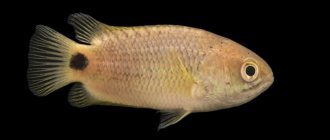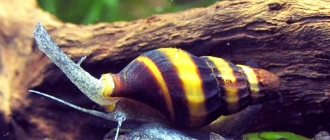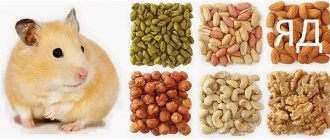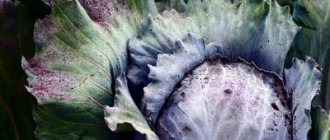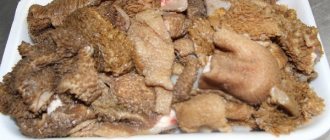The coil snail is one of the most famous species of the gastropod family. This small creature is easy to care for and does not require special conditions. It can accidentally get into the aquarium and bring a lot of benefits to the artificial reservoir. However, if not properly cared for, coils can pose a health hazard to other inhabitants, as they are carriers of various diseases.
Often these small aquarium mollusks appear accidentally - small snails or their eggs can be brought in with the plants.
Description and features
Coil snails are creatures that are very common in nature and belong to a type of freshwater mollusk. Their bodies are simple. Their most noticeable and massive part, accounting for 90% of their body weight, is the translucent shell. In color it can be brown, red, pink or other similar shades.
But the shape is necessarily spiral, as if flattened on the sides. Its growing coils, about 3 mm thick, are twisted one above the other. The number of curls varies, starting from four, but, as a rule, their number does not exceed eight. This structure resembles a coil, which became the reason for the name of all representatives of the coil family.
The shell can be considered an external skeleton, shell, or even a house, because this solid part of the body, which has a multi-layered structure, is intended for snails to hide there for the owners from the dangers and inconveniences of the outside world.
Important internal organs for life are also hidden there, which, if desired, can be viewed through the translucent walls of the shell. Among them are large lungs, which allow these snails, which belong to the order of pulmonary creatures, to breathe ordinary air while being out of water for some time, which is still their main habitat.
The same function, but to a lesser extent, is performed by the skin of these organisms. In water, breathing is carried out through peculiar gills, which are just folds of skin penetrated by blood vessels.
The coils have a small heart that distributes blood throughout the body, which, by the way, due to the structural features of snails, is not red at all. There is also an air bubble inside the shell, which allows these mostly aquatic creatures, by changing its volume, to descend to the bottom at will, reducing the buoyancy force, or rush higher to the surface of the reservoir due to a general decrease in density.
Muscles are attached to the shell, as well as a fold of skin - the mantle, which connects the shell with the rest of the snail's body, which usually has approximately the same color shade as the shell. The body itself has an elongated shape, narrowing towards the front.
The head of such creatures is equipped with paired thin and long tentacles that look like horns. At their ends there are poorly developed eyes, only capable of separating light from darkness.
Like all snails, these creatures move smoothly and slowly on a single wide leg with the help of wave-like contractions of the muscles of the flat sole, and the mucus secreted in abundance facilitates successful gliding. The appearance of these creatures is clearly visible in the photo of the coil snail .
General information
The coil mollusk belongs to the order of pulmonary snails that can live without water for some time and breathe air. She quickly adapts to her new living conditions and is able to survive even in the most extreme conditions.
Description of the species
Before you acquire this representative of the aquatic fauna, you need to decide what the reel looks like and what behavioral features it has.
The first thing aquarium lovers pay attention to is the shell of a mollusk. It is spiral-shaped and can have from 4 to 8 curls
Their number depends on the age of the creature and its size. The weight of the snail’s “house” can reach 90% of the total mass. It is translucent and can come in a wide variety of shades. The internal organs of the mollusk are clearly visible through the shell.
Inside the coil stores a small air bubble, which helps it descend to the bottom of the reservoir and rise to the surface. This type of snail is classified as small, as it can only grow up to 4 centimeters in length. At home, this figure is significantly lower than in the wild and rarely exceeds 1 cm. An interesting feature of the coils is that the larger the population lives in the aquarium, the smaller the size of the individuals will be.
The reel moves slowly and smoothly, like all other types of its family. Movement occurs thanks to a wide leg with a flat sole. At the same time, the snail produces a small amount of mucus, which greatly simplifies this process. However, this negatively affects the ability to swim on the surface of the reservoir. This type of mollusk has an “iron character” and can lead its usual way of life even in the harshest conditions.
The snail breathes with the help of a large lung, which occupies most of the space inside the shell. In addition, the coil can receive oxygen through the skin, but its amount is not enough to lead a full life and reproduce.
The small round head of the snail has paired tentacles and horns. At the ends of the latter there are organs of vision. They are very poorly developed and are able to distinguish only daytime from nighttime. The mollusk has a full circulatory system and a tiny heart. His blood contains a small amount of hemoglobin, which colors it scarlet.
Popular types
In most cases, the home inhabitant becomes the horned or horned red coil, but the diversity of the species does not end there. The aquarium coil snail can be found in the wild and have a slightly different appearance. The most famous of them are:
- Horny. This mollusk is widespread throughout Europe and Asia. You can often find it in the Caucasus and the Russian Federation. The horned reel likes to hide in dense vegetation and spend its entire life there. It feeds near the bottom of the reservoir. There the snail is looking for soft food (rotten leaves, plants, animals, silt), which is suitable for its weak jaws. This species of snail rarely grows more than 3.5 cm and has a maximum of 5 coils on its shell, which is colored olive or pink.
- Horny red. This representative of the aquatic fauna is one of the smallest in its family. The mollusk grows to only 2 centimeters in diameter and has a bright red shell. Otherwise, the behavior and lifestyle are very similar to the horn coil.
- Far Eastern. The main habitats of this mollusk are the wetlands of East Asia. A distinctive feature of the species are several oblique wavy lines located throughout the shell.
- Keeled. This snail is distinguished by its thin “house”, which is approximately comparable in size to the Far Eastern one. The mollusk got its name due to the small seam (keel) that runs along the shell of the shell and divides it into two equal parts. The keel reel feeds on food debris at the bottom of an artificial or natural reservoir.
- Wrapped. The main feature of this reel is its transparent shell. It never exceeds 1 centimeter in diameter, has low strength and is yellowish in color. In the wild you can find it in water bodies of Asia, Europe and Siberia. This species is distinguished by its fertility and good adaptive abilities, so it often fills the entire reservoir and causes irreparable harm to the ecosystem.
The snail can also move on the surface of the water, turning its shell down due to the air bubble that is in the shell.
Kinds
These organisms are extremely fertile and viable, and therefore exist and reproduce successfully in a wide variety of, sometimes very harsh, conditions. That is why such snails are distributed almost all over the world; moreover, they often find themselves in the most unexpected places, for example, in aquariums, where they can end up completely by accident.
The size of snails in artificial small reservoirs usually does not exceed a centimeter, and the diameter of their shell is less than 7 mm. Although in natural wild conditions there are specimens whose length reaches 4 cm. Moreover, not only their size, but also their appearance is somewhat different from aquarium inhabitants.
There are different types of snail coils . The number of varieties is considerable, and they all combine with several dozen genera in the family of coils. We will give a special description of the most famous and widespread of them.
1. The horn coil is considered the largest of the entire family. The shells of such creatures at early stages of development of an individual have a cylindrical shape, and only later they take on a disc-shaped shape, having about five curls and reaching several centimeters in diameter. Such organisms are common in various regions of Eurasia, usually in areas with dense vegetation. The tentacle horns of representatives of this species are well developed, which is why they earned their name.
2. The horny red coil is similar in many ways to the previous variety, but in comparison with it it is small in size. Its shell is only about 2 cm in diameter, but has an impressive color, bright purple with a reddish tint. Having this color, the snail looks great against the background of green algae in the aquarium, where it, like its sister in the family described above, is a frequent visitor. The tentacle antennae of the red coil are also developed and visible quite well.
3. Anisus is a whole genus in the family of coils. They live on the vegetation of fresh water bodies and are very small in size, about 1 cm. The shells of such organisms can be very diverse in shape, but are always flat and spiral-shaped. Their color also varies significantly, it can be grayish, lighter or darker, and also cream. There are also white coil snails of this variety.
4. Planorbis (or fringed coil) is also a freshwater genus of the family. The shells of such creatures look symmetrical along the axis only at first glance. But in fact, they are twisted not only into flat spirals, but, judging by the circular transverse marks, they have a shift in all three dimensions.
They are quite large in size: only their thickness is a centimeter, but in diameter such a shell reaches a length of more than 3 cm. Its shades in different species can vary from brown to cream. The body of such mollusks is conical.
On the tentacles of the head they have light-sensitive cells. Representatives of the genus are widely distributed throughout the world. In Russia they are found in Central European regions. But only heat-loving tropical species, of which there are also plenty, take root in the aquarium.
5. Wrapped coil . Its shell is not just spiral-shaped, it is so flat that it looks like a twisted cord, which also resembles the antlers of a deer. The length of such a coil, if it could be unfolded, would be about 75 mm with a true diameter of up to one and a half centimeters.
The color of the shell can be gray or yellow, and sometimes consists of combinations of these colors in various variations. The body itself of such creatures is slender and long, dark in color with the addition of reddish tones. The short leg is rounded at the back and blunt at the front. This type of snail is found in Europe and Siberia.
6. The Far Eastern coil has a very beautiful translucent shell, about 10 mm in diameter, with a red-brown background, decorated with a pattern of graceful, thin, wavy and oblique lines.
The curls of the shell, the number of which reaches six, smoothly become wider as the radii of their circles increase, which provides a geometrically very pleasing shape to the eye. Such interesting creatures live in nature in East Asia, but they take root well in aquariums.
7. The keel coil has a seam on the shell that resembles a keel, which is why it gets its name. The diameter of its shell is about 2 cm. It is brown-gray in color. And therefore, such snails in an aquarium among the soil often go unnoticed. In nature, they live in many European regions, Central Asia and Siberia.
Are there living conditions requirements?
Coils are not particularly demanding of the environment. Despite the fact that in nature they live happily in polluted reservoirs with stagnant water of various temperatures, having adapted to indoor aquariums, the optimal water temperature for them has become within 22-28 ° C, without additional aeration and filtration.
The lack of requirements for saturating water with oxygen is also explained by the fact that the coils can breathe oxygen from the air. Periodically, they float to the surface and swallow it from above the aquarium space.
Snails love calm, non-moving water. They crawl freely along the bottom or walls of the aquarium, picking up leftover food and fallen rotten leaves.
They do not dig up the soil; they show indifference to the roots of plants. They live in the bottom space, if you exclude floating to the top. Omnivorous and harmless. Not hunters, not capable of aggression, they easily get along with small, peace-loving fish.
A calm character is evident from the moment it enters the aquarium. Sometimes it is invisible. The aquarist himself sometimes wonders how his aquarium was filled with such numerous small guests? And they can arrive in the form of small newborn snails stuck in the roots of transplanted plants or together with the replaced soil.
They reproduce quickly and easily, especially if there is a lot of food. It is not necessary to carefully care for them. Their brightly colored or spotted house against the background of green algae looks beautiful and a little mysterious.
Lifestyle and habitat
In nature, reels usually choose shallow freshwater bodies of water for their place of residence, most often with a stagnant or extremely slow current. They live in lakes, ponds, canals, rivers, sometimes even streams.
In such places there is usually a lot of different rotting underwater vegetation. This is where these creatures settle, for example, perching on the leaves of water lilies and egg capsules, most often on their underside. All this serves them as both home and food.
The reservoirs that house the reels can be not only permanent, but also formed only temporarily. And this is not scary for creatures that are able to breathe with their lungs and are able to stay without water for some time. If the reservoir dries out, then such snails bury themselves in mud or silt, completely hide in the shell and seal it securely with the help of a dense film they secrete.
And in this state they are able to exist for about three months in the hope of better times, in anticipation of heavy rains and replenishment of shallow reservoirs. In this case, the body of the mollusks dries out and loses almost half of its mass, but then, if the outcome is favorable, it is restored.
In an aquarium, the coil snail is the most unpretentious resident. There is no need to create special conditions for keeping such creatures. They are little affected by water parameters, the degree of its contamination, the volume of the vessel and temperature changes.
They adapt to new conditions quickly, and therefore even beginners can breed them. But still, if there is a need for the reels to grow and reproduce better and faster, you need to try to create for them conditions similar to those that exist in their natural habitats, or even more favorable.
To do this, you need to take into account the following information.
- The water temperature is not very important for the life of such snails, as long as it is above zero and does not freeze. But still, an environment of approximately +25°C is considered ideal for them, since mostly tropical species of coils settle in aquariums.
- The container where these creatures have taken root should be constantly cleared of dead snails so that their decomposition does not affect the quality of the water. Dead coils can be distinguished from living ones by bloody discharge inside the shell and an unpleasant odor emitted.
- The liquid in the aquarium should be regularly replenished with special preparations that increase the percentage of calcium in the water. The coils are in great need of this substance, which plays a huge role in the formation of shells, and if there is a shortage of it, they can even die.
- It is better to cover the container where such snails live on top with a flat, preferably transparent covering with small holes made there to allow air to penetrate into the container. This is done so that the coils, which suddenly decide to travel, do not decide to go on the run, because these creatures climb on any type of surface just perfectly.
Nutrition
These organisms for the most part prefer a plant-based diet. In the natural environment, they are fed by precisely those representatives of the flora on which they have settled down to live. And this is of course very convenient. Having a huge number of microscopic teeth, the coils, like a grater, scrape off plants piece by piece and absorb them.
While in the aquarium, they especially like to feast on small algae, gradually removing their green coating, raking it up with their “grater”, like a shovel. It is extremely interesting to observe this process through aquarium glass.
These creatures also show interest in animal food. For example, in captivity they can be fed raw meat, and they eat it very willingly. Although such snails have enough pasture in an artificial environment.
They consume dead fry, small invertebrates, remains of fish food, and rotting algae. But if you wish, you can pamper them with herbs, salad, vegetables, for example, cucumbers or zucchini.
Reproduction and lifespan
Such mollusks have no gender, or rather, they simultaneously bear both female and male characteristics of an individual, that is, they are considered hermaphrodites. Therefore, the reproduction of the coil snail occurs in almost any environment and unusually quickly, provided, of course, that these creatures are sufficiently mature, that is, they have reached the age of one year.
Although, to be completely precise, coils are capable of self-fertilization, but upon contact with each other they can also mutually exchange genetic material. And representatives of some species do not reproduce in isolation at all.
In nature, these very prolific mollusks leave their eggs glued to the surface of algae or to some other underwater objects. Snails also do this when living in an aquarium, using the walls of the tank and surrounding vegetation. In artificial environments, this process can be carried out without outside participation and occurs easily and quickly, provided there is sufficient nutrition and an acceptable temperature.
The caviar of the coil snail is round in shape, pinkish in color, and quite transparent, which makes it invisible. It is deposited in a gelatinous substance, which ultimately takes the form of a flat, pancake-shaped growth on the leaf. This “cake” has a light brown or yellowish, sometimes slightly different color. In total, large individuals can have up to 70 eggs in their clutch, but small ones have significantly fewer eggs.
The rate of development of eggs depends on the state of the environment, for the most part its temperature indicators. In general, changes happen quickly. Under favorable conditions, two weeks are enough for the egg to form a tiny but rapidly growing snail. The young generation is very viable; young animals are able to move around and eat the same things that adults eat.
The shells of small snails are transparent and thin, and they become stronger as the mollusk itself grows. Such organisms have special glands that extract limestone particles from the water and deposit them along the edge of the mantle of the shell. Thus, growth rings appear on the shells, indicating the age of the organism.
Coils can live in an aquarium for no more than three years. But under natural conditions, even this short period is significantly reduced. And this circumstance is greatly facilitated by the predatory enemies of snails: aquatic birds, small reptiles, amphibians, who eat them with pleasure.
Features of keeping coil snails
In captivity, these inhabitants live from 2 to 4 years, but more often their life cycle does not exceed 2 years. There are no special requirements for their content, except that it is worth considering the following nuances:
- the most suitable temperature of the aquatic environment is 22°-28°C, although these gastropods tolerate changes well;
- the bodies of snails consist of protein components, and when they die, the decomposition process occurs very intensively, this spoils the water, so the dead inhabitants should be removed immediately;
- an aquarium with coils must be equipped with a lid, otherwise these inhabitants will periodically run away and die;
- Mollusks do not require special nutrition - they eat leftover fish food and rotting greens; in addition, they can be treated to pieces of vegetables.
Benefits and harms
It is widely believed that coils are notorious aquarium pests. But it is not so. Of course, they can become a real disaster for the microclimate of a small artificial reservoir and its inhabitants.
Moreover, such creatures reproduce unusually quickly. Not only do they turn out to be carriers of parasites and some dangerous diseases, these snails voraciously destroy healthy, useful and necessary plants and pollute the water in containers with their feces.
But the harm of the coil snail is not always so catastrophic. In small quantities they can be quite beneficial and have a positive effect on the environment in which they take root. The snails remove plaque from the walls of the container and eat rotting algae, which, by the way, they prefer to healthy ones.
And they eat useful aquarium flora only when there is a shortage of food. Such mollusks absorb the remains of fish food, thereby preventing rotting and disorder, that is, pollution of the aquatic environment around them.
In the end, the benefit of a snail coil is that it itself is pleasant to look at, decorates an aquarium and creates coziness in the home. That is why they are often not destroyed, but rather bred in glass containers and their existence is encouraged in every possible way. In addition, such small organisms themselves are suitable as food for many species of fish. And this shows real savings in time, effort and finances.
Why are they harmful?
Despite the fact that the benefits of snails are quite great, many people prefer to get rid of the mollusks as soon as they discover the uninvited guest.
Coils are very prolific. They are hermaphrodites, and just a couple of snails are enough to get a whole school of mollusks. Rapid reproduction leads to an increase in the amount of their waste products, which cause harm and pollute the aquarium.
If the snails do not have enough food, they will start eating aquarium plants. And not for rotten leaves, but for healthy ones. Hungry coils will quickly destroy the plant.
The spool snail can cause fish illness. This often happens when a snail is brought into aquarium conditions from a local reservoir. In such a situation, the fish will have to be treated with special drugs, which the snails most likely will not tolerate.
In general, an overgrown flock of snails spoils the appearance of the aquarium, hanging in whole clusters on the walls and plants.
Return to content
Keeled
How to get rid of it in an aquarium
Before declaring war on cute little reels, you should think carefully: is it worth doing this at all? Moreover, excessive efforts in this direction can lead to an imbalance of microflora and significant destabilization of aquarium life. And if you decide to be zealous, then it’s better without fanaticism.
But when such extermination seems reasonable, you should think about how to get rid of the coil snail quietly, peacefully, at home? It is better not to use chemicals here at all; this is an extreme, dubious measure. There are more moderate and natural methods.
First of all, you can force domestic fish to eat snails by reducing the amount of food offered to them. So with one blow it is possible to solve not one, but two problems at once. And, for example, such creatures as aquarium catfish consume the eggs of reels without any need and with great pleasure; they do not need to be forced.
It also makes sense to try placing some predatory species of snail in the aquarium, for example, Helena, whose main food is other mollusks. A couple of such creatures are enough for the population of coils to very quickly decrease to the required minimum.
Fertile pests can eventually be removed from the tank with your own hands by carrying out such cleanings regularly. And for active successful collection, there is one original, completely harmless and even useful method - banana peels that are thoroughly blackened after drying in a radiator or in the sun.
When placed in an aquarium, it becomes such an attractive object for snails that after a few hours these babies almost all gather on it. And all that remains is to get them together with the trap peel with one movement of the hand.
